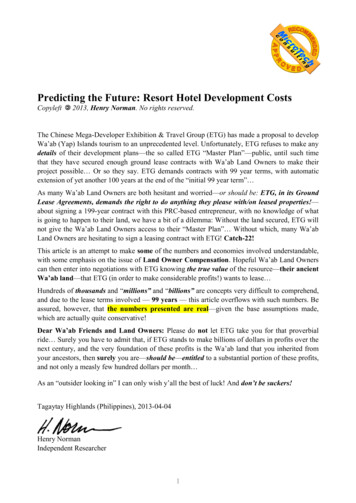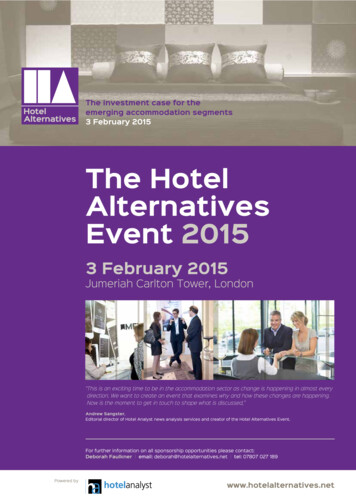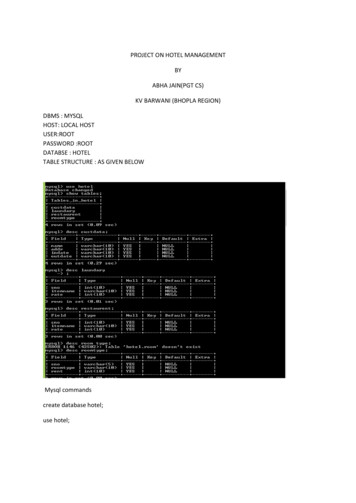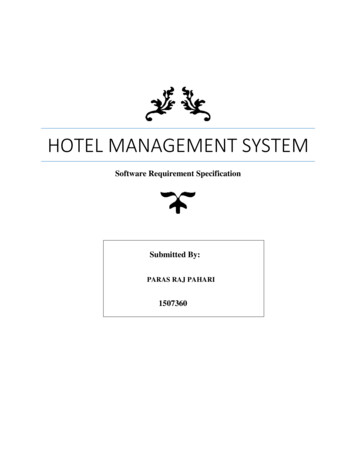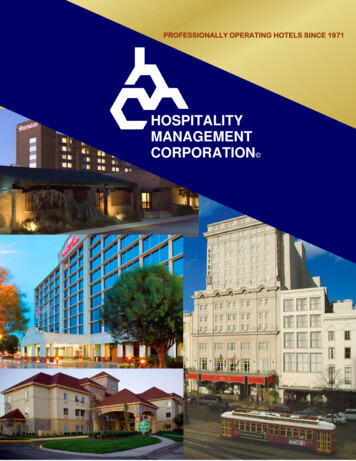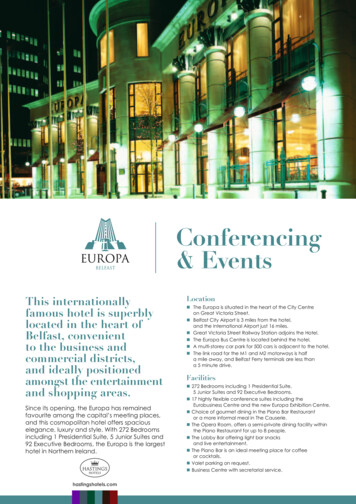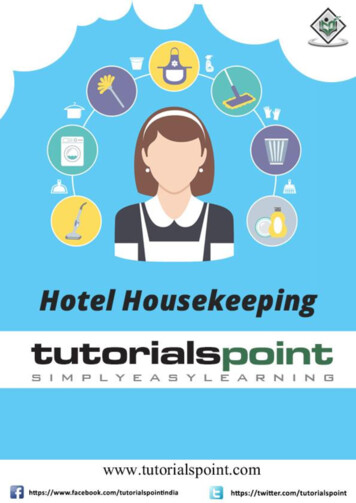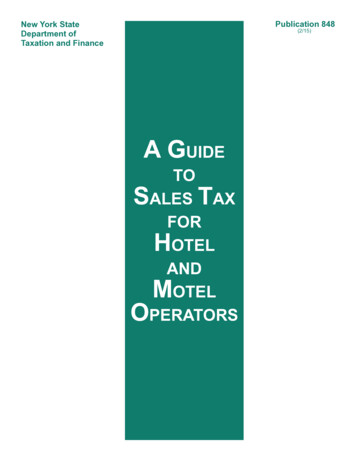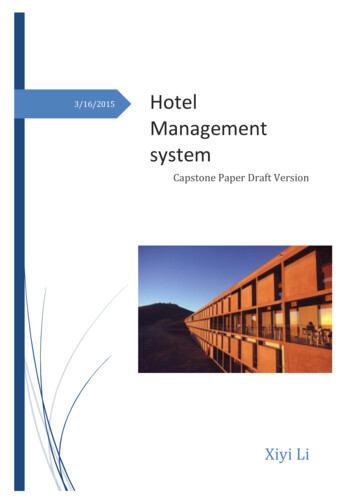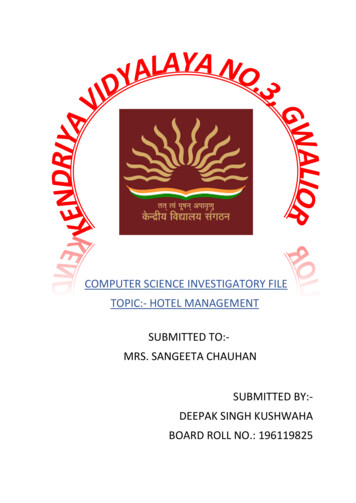
Transcription
Hotel Manager’s Guideto Water EfficiencyI
Hotel Manager’s Guide to Water EfficiencyOverview and Getting StartedHotels account for approximately 12 million gallons of New York City’s totalwater use each day. You can help reduce this amount and save money bylowering your property’s water consumption. First, this guide outlines stepsto get you started. Second, it highlights common hotel water uses that canoften be turned into water savings opportunities, such as housekeeping,laundry, food service, grounds maintenance, or landscape. Finally, it includesa list of tips for hotel staff on the last page.1
Getting StartedMeasure Your Water UseThe old saying, “you can’t manage whatyou can’t measure” holds true with wateruse in hotels. It is important to understandhow much water your hotel is consumingand how it is divided among the varioususes such as in the guest rooms andcommon areas. A great place to start iswith a thorough evaluation of water use in the property, also called an audit or sitesurvey. This can be done in-house or contracted out to a third party specialist. Anaudit includes collecting historic water bills and counting all the water using fixturesand appliances inside and outside of the building. Observing how water is used invarious operations such as cleaning guest rooms, laundry, and food service is also veryuseful. The evaluation should identify the associated water flows and estimated energyconsumption related to hot water use. Additional data such as occupancy rates areuseful during this assessment. A detailed water use profile will enable precise planningand implementation of improvements.2
It may also prove valuable to benchmarkwater use against similar hotel operations.A helpful resource for this is the U.S.Environmental Protection Agency’s (EPA)ENERGY STAR Portfolio ManagerDataTrends series. In fact, NYC Local Law84 requires buildings 50,000 square feetor more to benchmark annual water andenergy consumption using the ENERGY STAR Portfolio Manager.Identify, Evaluate, and Select Efficiency MeasuresAn audit of your property will reveal opportunities for reducing water use and providethe foundation for developing a strategy. It is important to evaluate and rank the variousoptions in terms of cost-effectiveness and qualitative factors such as the impact on theguest experience. Ideally, the selected measures will have a good return on investmentand have a neutral or positive impact on the guest experience.Plan, Implement, and MonitorCreating a plan that details the hotel water use profile and identifies the targeted areasfor efficiency improvements in those uses along with expected costs and benefits willhelp guide implementation. After the selected efficiency measures are put into action, itis important to monitor changes in water use. All hotels in NYC are equipped with watermeters and Automated Meter Reading (AMR) devices that track usage daily and in somecases hourly. Tracking water use data generated by your AMR device is as easy as settingup and logging into My DEP Account at nyc.gov/dep. Frequent monitoring can be done ina matter of minutes and will help identify leaks and other abnormal spikes in water use.»»Determine your total usage in My DEP Account and create a baseline»»Conduct an audit of your property to measure water consumption and generate awater use profile»»Identify, evaluate, and select efficiency measures»»Plan and implement efficiency measures»»Track implementation progress and changes in water consumption»»Monitor water use frequently via MY DEP Account3
Guest RoomsTotal water consumption varies from hotel to hotel, but guest rooms often representthe highest water use. This is typically associated with toilets, showers, bathtubs,and lavatory faucets. Some hotels may include a kitchen in the room which will haveadditional water use. If the fixtures in the guest rooms are old and inefficient, theyshould be replaced with EPA WaterSense labeled products. This will ensure watersavings and satisfactory performance.Some hotels may use flushometer valve toilets in guest rooms. If so, 1.28 gallon perflush models are available and recommended. EPA WaterSense currently only labelstank-type toilets, but is pursuing a labeling program for flushometer toilets.Offering linen and towel reuse options to hotel guests will help lower waterconsumption at a very low cost and may appeal to environmentally consciousguests. It is important to provide adequate space for guests to hang towels so theycan completely dry between uses.The process employees use to clean guest rooms also has a large impact on waterconsumption. Linen and towel reuse programs are only effective if housekeeping staffadhere to the guest requests. Water waste may occur if staff flush toilets repeatedly4
and leave showers and faucets running longerthan necessary during cleaning. Standardizinga housekeeping cleaning process and educatingstaff in practices that promote wise water usewill encourage day to day water efficiency.Beyond reducing the number of toilet flushes andexcessive faucet use this may include changingcarpet cleaning methods from a steam or otherwet method to a dry powder method, changingthe window cleaning schedule from periodic to anon-call/as required basis, and using sustainablyproduced or green cleaning products. Additionalhousekeeping and cleaning tips for hotel staff canbe found at the end of this guide.»»Evaluate guest rooms in audit of your property»»Replace inefficient toilets, showerheads, faucets, and faucet aerators with EPAWaterSense labeled products»»Offer guests the option to reuse linens and towels and make signs visible andeasy to understand»»Check for and fix any leaks and malfunctioning fixtures»»Develop a standardized housekeeping process to promote efficiency whencleaning guest rooms»»Change window cleaning schedule from periodic to an on-call/as required basis»»Switch from wet or steam carpet cleaning methods to dry powder methods»»Purchase sustainably-produced or green cleaning products for use within the hotelTIP: EPA WaterSense labeled tank toilets have a flushvolume of 1.28 gallons or less, EPA WaterSense labeledshowerheads have a flow rate of 2.0 gallons per minute orless, and EPA WaterSense labeled faucets and aeratorshave a flow rate of 1.5 gallons per minute or less.Water efficiency efforts should not stop at the guestroom. There are many other wateruses throughout the hotel that can be measured, managed, and reduced. There may alsobe opportunities to reuse water and capture rainwater for purposes such as irrigation.5
Overall Building and Common AreasIce MachinesIce machines are commonplace in the hospitality industry. In fact, hotels account forover 20 percent of all commercial ice machine purchases in the United States. Whilethe end product of an ice machine is frozen, a large amount of heat is generated inthe ice making process. This heat is cooledvia a water or air chilling system. Watercooled units may consume substantiallymore water than is needed to make theice. The biggest offender in terms of waterinefficiency is a water cooled ice machinewith a once through cooling system. Aircooled units are typically more waterefficient than water cooled machines.However, not all air cooled units are energyefficient. ENERGY STAR has labeled aircooled ice makers that save water and energy compared to conventional models. TheConsortium for Energy Efficiency also maintains a list of water and energy efficientice makers. These references can be very useful in selecting an efficient machine toreplace inefficient units.6
In addition to replacing inefficient ice makers, it may also be possible to reduce thenumber of machines in the building. And don’t forget to check ice machines for leaks.»»Evaluate the water and energy consumption of ice machines installed during thewater audit of your property»»Replace inefficient ice machines with water and energy efficient units»»Consider reducing the number of ice machines in the building if feasible»»Check ice makers for leaks and make any necessary repairsLaundryAlthough many New York City hotels contract their laundry out, there are some largehotels that have laundry facilities in-house. Whether laundry is done in-house orcontracted out to a thirdparty, there is opportunity toreduce the associated waterconsumption. Offering toweland linen reuse programs tohotel guests as described inthe Guest Room section, isa great place to start.When guests participatein a towel and linen reuseprogram, water is savedwith very little cost or efforton the part of the hotel. It is important to make signs communicating the program easyto find and easy to understand. In addition to clear instructions on how to participate,a message about the value of water and the need to conserve will help stimulateparticipation.In-house laundry equipment can be evaluated to ensure it is mechanically efficient andbeing operated in a way that prevents excessive water use. Making sure the machinesrun with full loads and at proper water levels is fundamental. Commercial launderingequipment varies based on the facility’s requirements and should be a focal point ofyour property audit. There may be opportunities for water reuse in the system as wellas the installation of an ozone system. Sub-metering water consumption in laundry7
facilities will also help monitor for high levels of use. As of January 1, 2011 the New YorkCity Plumbing Code requires water distribution pipe lines serving a commercial laundryfacility to be equipped with a sub-meter.If laundry is outsourced, management can contract with a service provider thatuses efficient practices, or speak to their current provider about making efficiencyimprovements.»»Offer guests the option to reuse linens and towels using eye catching signagewith easy to follow instructions»»Evaluate in-house laundry equipment for possible replacement or retrofit as partof your property audit»»Ensure laundry equipment is being operated efficiently»»Run the washing machine only with a full load Minimize rinse cycles as much as possible without reducing quality Use the correct amount of soap to load size so extra rinsing is not required»»Install a sub-meter to monitor water use in the laundry facility if one is notinstalled already»»Seek laundry service providers that use efficient practices, if outsourcedTIP: Each set of towels and bed sheets take approximately 6 to 8 gallons ofwater to launder.Pool and SpaPools and hot tubs requirelarge amounts of water foroperation and may be a sourceof great water savings. Propermaintenance can reduce waterlost to evaporation and leaks,and reduce the frequency thewater has to be replaced. Leaksare often found in the variousplumbing connections, at separations along the pool top, and in the liner, sidewalls, andfloor of the pool itself.8
Manually washing filters instead of backwashing can save water and result in a morethorough cleaning. Using pool covers and controlling the water temperature can helpreduce water lost to evaporation. Because there is a possibility for large amounts ofwater to be lost to leaks and evaporation, it may be worth the investment to install asub-meter to the pool makeup line. This will allow the operator to monitor water useand identify leaks. As of January 1, 2011 the New York City Plumbing Code requiresnewly installed swimming pools to be equipped with a makeup line sub-meter.»»Inspect pool and spa for leaks on a routine basis and make needed repairs»»Clean filters manually instead of backwashing if feasible»»Maintain a proper chemical balance to avoid the need to drain the pool»»Maintain a lower pool temperature to reduce evaporation, particularly when notin use»»Use a pool cover to prevent evaporation if practical»»Plug the overflow line when the pool is in use»»Install a sub-meter on the pool makeup line if one is not installed alreadyTIP: A small leak the size of a pinhole can lose 30,000 gallons of waterin one month.Common AreaRestroomsLike the bathroom found in guestrooms, common area restroomscan be updated to promote waterefficiency. While the prescription isgenerally the same, men’s commonarea restrooms also contain urinals.These fixtures often have potentialfor efficiency improvements andEPA WaterSense has labeled urinals that are water efficient (0.5 gallons per flush) andperform well.The toilets found in common area bathrooms may use flushometer valves. EPAWaterSense currently only labels tank-type toilets, but is pursuing a labeling programfor flushometer toilets.9
Staff can develop a process for sanitizing and cleaning common area restrooms thatavoids wasting water such as leaving faucets running and excessive toilet flushing.»»Evaluate common area restrooms in the water audit of your property»»Replace inefficient toilets, urinals, showerheads, faucets, and faucet aeratorswith EPA WaterSense labeled products»»Check for leaks and malfunctioning fixtures on a regular basis and make neededrepairs»»Develop a cleaning and sanitation process that avoids excessive water useFood ServiceWater use associated witha hotel restaurant, bar,banquet service, and roomservice can often be reducedthrough the replacementof inefficient fixtures andappliances and by changesin behavior or operations.The audit of your propertywill identify specific targetsunique to each operation, but there are some common features.Food cooking is often done with food steamers that use a central boiler. These steamersoften consume large amounts of water and it may be cost-effective to replace them witha more efficient connectionless steamer or combination oven.Dish cleaning offers opportunities for savingwater as well. Before plates and dishesare loaded into the dishwasher they areoften cleaned with a pre-rinse spray valve.Replacing an old pre-rinse spray valve,(which may use 2 to 5 gallons per minute)with an EPA WaterSense labeled modelusing 1.28 gallons of water per minute willyield significant savings at a low cost.10
Dishwashers are often one of thelargest water and energy consumersin a commercial kitchen. There aremany types and sizes of commercialdishwashers and the audit will helpdetermine if an upgrade is necessaryand cost-effective. Dishwashershave a life expectancy of 20 to 25years, indicating there are likelymany inefficient units installed thatcan be replaced with newer and more efficient technology.Improving the efficiency of pre-rinse spray valves and dishwashers will save hot water,which in turn will lower the facility’s energy use.In addition to being found in hotel common areas, ice machines are present in areaswhere food and drinks are being prepared and served. These should be evaluated andupgraded if feasible.Kitchen operations can also be examined to identify any possible water waste that can bemitigated. For example, faucets are sometimes left running continuously. Modifying anywater wasting behavior will provide a benefit at a very low or even zero cost. Sub-meteringwater consumption in food service facilities will also help monitor for high levels of use. Asof January 1, 2011 the New York City Plumbing Code requires water distribution pipe linesserving a commercial kitchen facility to be equipped with a sub-meter.»»Evaluate kitchen equipment, as part of the property audit, for potentialreplacement Food steamers Dishwashers Pre-rinse spray valves Ice machines»»Check for leaks and malfunctioning equipment on a regular basis andmake needed repairs Modify any water wasting behavior such as letting faucets run continuously Install a sub-meter to monitor water use in the food service facility if one isnot installed already11
Floor CleaningHotel operations require cleaning of hard surfaces such as sidewalks, patios, pooldecks, walkways, and kitchen floors. The cleaning process often includes the use of ahose. It is important to use water as efficiently as possible when cleaning hardscapes.This can be done by using dry cleaning practices when possible and equipping hoseswith self-closing nozzles.»»Use dry cleaning methods when possible»»Use a self-closing nozzle if a hose is needed for floor cleaning»»Consider the use of an efficient waterbroom if wet cleaning is requiredTIP: Waterbrooms provide an alternative that allows a wet cleaning methodat a lower flow rate (1 gallon per minute) compared to standard hose andnozzle which typically flow at 5 gallons per minute.LeaksImprovements in water efficiency oftenfocus on water fixture and applianceupgrades and changes in water usingbehavior. A fundamental part of reducingwater consumption is eliminating leaksin plumbing systems, in the variouswater using fixtures and appliances, andin pools and spas. A water audit of yourproperty will identify leaks that can berepaired, however, it is important to stay vigilant to identify and repair new leaks as theyoccur. Even leaks the size of a pinhole can waste thousands of gallons per month. Leakscan be hard to find, so take advantage of your Automated Meter Reading device andDEP’s free Leak Notification Program by setting up a MY DEP account online. It is easyand can help save a lot of water and money.»»Fix leaks identified during the property audit»»Continue to regularly check for and fix leaks»»Set up a Leak Notification alert at My DEP account12
IrrigationSome hotels have outdoor space requiring irrigation. If this is the case, incorporatingefficient irrigation practices can yield large water savings. Simple operationalmodifications, such as notwatering plants duringthe heat of the day, canhelp reduce the amountof water used to irrigate.Planting a water-smartlandscape with nativeplants that require littleirrigation and usingsoils that hold moistureare other strategiesto improve water useefficiency. If there is an automatic irrigation system in place it should be equipped withwater savings devices and of course checked for leaks. Rain sensors, soil moisturesensors, and weather based irrigation controllers utilizing evapotranspiration informationcan be installed to prevent the irrigation system from operating when it is not needed.There may also be opportunities for rainwater capture and other types of on-site waterreuse that can be used for irrigation.»»Avoid watering plants and turf during the heat of the day»»Select native plants that require little or no watering»»Select soil that retains moisture and reduces watering requirements»»Equip irrigation systems with controllers that prevent watering when it isnot needed»»Irrigate with harvested rainwater and other water captured on-site13
Cooling TowersCooling towers are often used in hotels to cool the building via the HVAC system and canbe a leading source of water use. Proper maintenance and retrofits such as conductivitycontrollers and pH controllers can greatly reduce the water use of a cooling tower. Anycooling towers should be closely inspected during an audit. It may be cost-effective tometer cooling towers in buildings with large cooling requirements; cooling towers mayrepresent a large portion of your property’s water consumption. As of January 1, 2011the New York City Plumbing Code requires newly installed cooling towers to be equippedwith a makeup line sub-meter. Properties must have a dedicated meter for coolingtower make-up lines in order to qualify for a wastewater allowance through NYC DEP. Awastewater allowance prevents a property from being charged for water that does notget discharged into the sewer.»»Maintain and retrofit cooling towers to promote efficiency»»Install a sub-meter to monitor cooling tower water use if one is not installedalreadyTIP: As of January 1, 2011 the NYC Plumbing Code requires cooling towerand swimming pool makeup lines to be equipped with a sub-meter.The Plumbing Code also requires sub-meters for commercial cookingfacilities, commercial laundry facilities, and commercial gyms or spas.14
Rainwater Harvesting and Water ReuseEach property is unique, but some hotels will havelarge roofs that can be used to collect rainwater,and additional impervious surfaces such as parkinglots that can be used to gather stormwater. Theremay be other opportunities to capture water onsite from things like air-conditioner condensate,steam condensate, cooling tower blow down,swimming-pool backwash, and reverse osmosisreject water. Graywater and blackwater systemsmay also be viable options for on-site water reuse.Harvested rainwater and other water captured onsite can be used to irrigate turf and other plants,supply cooling towers with water, and flush toiletsand urinals. Con Edison steam customers can also use condensate to preheat domestichot water through a heat exchanger. This reduces water consumption in two ways: (1) itoffsets total steam consumption, and (2) reduces the amount of water used to cool thecondensate before it is released into the sewer.»»Evaluate the property for the potential to harvest rainwater and stormwater»»Inspect equipment such as air-conditioners, steam systems, cooling towers,pools, and reverse osmosis systems for possible capture of water that can bereused»»Evaluate the potential for graywater and blackwater systems»»Identify possible uses for recycled water and water captured on-site such asirrigation, cooling tower make-up, and toilet and urinal flushing»»Treat recycled and captured water to meet the quality standards of itsintended use»»Preheat domestic hot water with steam condensate if feasibleThese potential options can be evaluated during the water audit of your property. It isimportant to know what is allowed by the NYC Plumbing Code and treat water to meetthe quality standards of its intended use. Agencies that may have jurisdiction include,but are not limited to, the New York City Department of Buildings, the New York CityDepartment of Health, the New York City Department of Environmental Protection, andthe New York State Department of Environmental Conservation.15
Educate and Engage StaffStrategies to improve water savings will require staff participation to be successful.For example, if staff does not adhere to the hotel linen reuse program, no water willbe saved. The same would be true if a housekeeping protocol were developed to useless water for guest room cleaning. Keeping staff informed of water savings efforts,asking them to share ideas and take leadership, and ensuring staff feel invested in andresponsible for reaching efficiency goals will help maximize the impact of efforts.Guest AwarenessIncreasing guest awareness of water efficiency efforts andthe importance of using water wisely will help increaseparticipation in hotel linen reuse programs and preventwasteful practices like taking long showers and letting thefaucet run when it is not in direct use. Simple steps suchas making linen reuse placards and signs easy to findwith clear instructions can have a large impact.16
Tips for Water-Efficient HousekeepingGUEST ROOM»»Adhere to hotel reuse linen/towel program to reduce laundry.»»Make sure linen/towel changing cards and other water conservation cards are inplace for guests to find and easily read.»»Minimize water use during the room cleaning wherever possible.»»Turn off the tap during cleaning if not being used for cleaning purposes.»»Flush the toilet only when necessary during cleaning.»»Report leaking faucets and showerheads to maintenance immediately.»»Report running toilets and toilets that flush poorly or have other issues.»»Use a bucket to catch excess water from a running shower or sink and reuse forother purposes, such as mopping the floor or watering plants.»»Do not use running water to melt ice in sinks.»»Save opened bottles of water to water plants.»»Do not replace unopened bottles of water in the rooms.»»Ensure thermostat is set as instructed by management to save energy and water.LAUNDRY ROOM»»Run the washing machine only with a full load.»»Minimize the rinse cycle as much as possible without reducing quality.»»Use the correct amount of soap to load size so extra rinsing is not required.OUTDOOR»»Do not use hoses to wash walkways. Use a broom to brush debris away instead.»»Water during the morning or evening instead of middle of the day.»»Report broken or leaking irrigation equipment, such as hoses and sprinkler heads.POOL AND SPA»»Inspect pool and spa for leaks on a routine basis and make needed repairs.»»Clean filters manually instead of backwashing if feasible.»»Maintain a proper chemical balance to avoid the need to drain the pool.»»Maintain a lower pool temperature to reduce evaporation, particularly whennot in use.»»Use a pool cover to prevent evaporation if practical.»»Plug the overflow line when the pool is in use.17
For more information, scan the code below or visithttp://nyc.gov/dep/conservation/hotelsBrought to you byWith support from
the end product of an ice machine is frozen, a large amount of heat is generated in the ice making process. This heat is cooled via a water or air chilling system. Water cooled units may consume substantially more water than is needed to make the ice. The biggest offender in terms of water inefficiency is a water cooled ice machine
